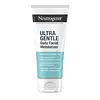What's inside
What's inside
 Key Ingredients
Key Ingredients

 Benefits
Benefits

 Concerns
Concerns

 Ingredients Side-by-side
Ingredients Side-by-side

Water
Skin ConditioningGlycerin
HumectantDicaprylyl Ether
EmollientCaprylic/Capric Triglyceride
MaskingNiacinamide
SmoothingCetyl Alcohol
EmollientCentella Asiatica Extract
CleansingPanthenol
Skin ConditioningTocopheryl Acetate
AntioxidantStearic Acid
CleansingPalmitic Acid
EmollientButylene Glycol
HumectantCaprylyl Glycol
EmollientCetearyl Alcohol
EmollientDimethicone
EmollientCeteareth-20
CleansingCarbomer
Emulsion StabilisingPhenoxyethanol
PreservativeChlorphenesin
AntimicrobialSodium Hydroxide
BufferingSodium Citrate
BufferingCitric Acid
BufferingWater, Glycerin, Dicaprylyl Ether, Caprylic/Capric Triglyceride, Niacinamide, Cetyl Alcohol, Centella Asiatica Extract, Panthenol, Tocopheryl Acetate, Stearic Acid, Palmitic Acid, Butylene Glycol, Caprylyl Glycol, Cetearyl Alcohol, Dimethicone, Ceteareth-20, Carbomer, Phenoxyethanol, Chlorphenesin, Sodium Hydroxide, Sodium Citrate, Citric Acid
Aloe Barbadensis Leaf Juice
Skin ConditioningEmulsifying Wax Nf
Caprylic/Capric Triglyceride
MaskingGlycerin
HumectantLeptospermum Scoparium Branch/Leaf Oil
TonicCocos Nucifera Oil
MaskingCarbomer
Emulsion StabilisingTocopheryl Acetate
AntioxidantCellulose Gum
Emulsion StabilisingSodium Hyaluronate
HumectantTapioca Starch
Titanium Dioxide
Cosmetic ColorantDaucus Carota Sativa Seed Oil
EmollientPanthenol
Skin ConditioningAvena Sativa Kernel Flour
AbrasiveButyrospermum Parkii Butter
Skin ConditioningOlea Europaea Fruit Oil
MaskingCamellia Oleifera Seed Oil
Skin ConditioningSodium Hydroxide
BufferingAscorbic Acid
AntioxidantPlumeria Alba Flower Extract
Skin ConditioningOat Amino Acids
Skin ConditioningDimethyl Sulfone
SolventGluconolactone
Skin ConditioningEthylhexylglycerin
Skin ConditioningAloe Barbadensis Leaf Juice, Emulsifying Wax Nf, Caprylic/Capric Triglyceride, Glycerin, Leptospermum Scoparium Branch/Leaf Oil, Cocos Nucifera Oil, Carbomer, Tocopheryl Acetate, Cellulose Gum, Sodium Hyaluronate, Tapioca Starch, Titanium Dioxide, Daucus Carota Sativa Seed Oil, Panthenol, Avena Sativa Kernel Flour, Butyrospermum Parkii Butter, Olea Europaea Fruit Oil, Camellia Oleifera Seed Oil, Sodium Hydroxide, Ascorbic Acid, Plumeria Alba Flower Extract, Oat Amino Acids, Dimethyl Sulfone, Gluconolactone, Ethylhexylglycerin
 Reviews
Reviews

Ingredients Explained
These ingredients are found in both products.
Ingredients higher up in an ingredient list are typically present in a larger amount.
This ingredient is an emollient, solvent, and texture enhancer. It is considered a skin-softener by helping the skin prevent moisture loss.
It helps thicken a product's formula and makes it easier to spread by dissolving clumping compounds.
Caprylic Triglyceride is made by combining glycerin with coconut oil, forming a clear liquid.
While there is an assumption Caprylic Triglyceride can clog pores due to it being derived from coconut oil, there is no research supporting this.
Learn more about Caprylic/Capric TriglycerideCarbomer is a polymer of acrylic acid. Its main role is to create a gel consistency.
A high amount of carbomer can cause pilling or balling up of products. Don't worry, most products contain 1% or less of carbomer.
Glycerin is already naturally found in your skin. It helps moisturize and protect your skin.
A study from 2016 found glycerin to be more effective as a humectant than AHAs and hyaluronic acid.
As a humectant, it helps the skin stay hydrated by pulling moisture to your skin. The low molecular weight of glycerin allows it to pull moisture into the deeper layers of your skin.
Hydrated skin improves your skin barrier; Your skin barrier helps protect against irritants and bacteria.
Glycerin has also been found to have antimicrobial and antiviral properties. Due to these properties, glycerin is often used in wound and burn treatments.
In cosmetics, glycerin is usually derived from plants such as soybean or palm. However, it can also be sourced from animals, such as tallow or animal fat.
This ingredient is organic, colorless, odorless, and non-toxic.
Glycerin is the name for this ingredient in American English. British English uses Glycerol/Glycerine.
Learn more about GlycerinPanthenol is a common ingredient that helps hydrate and soothe the skin. It is found naturally in our skin and hair.
There are two forms of panthenol: D and L.
D-panthenol is also known as dexpanthenol. Most cosmetics use dexpanthenol or a mixture of D and L-panthenol.
Panthenol is famous due to its ability to go deeper into the skin's layers. Using this ingredient has numerous pros (and no cons):
Like hyaluronic acid, panthenol is a humectant. Humectants are able to bind and hold large amounts of water to keep skin hydrated.
This ingredient works well for wound healing. It works by increasing tissue in the wound and helps close open wounds.
Once oxidized, panthenol converts to pantothenic acid. Panthothenic acid is found in all living cells.
This ingredient is also referred to as pro-vitamin B5.
Learn more about PanthenolSodium Hydroxide is also known as lye or caustic soda. It is used to adjust the pH of products; many ingredients require a specific pH to be effective.
In small amounts, sodium hydroxide is considered safe to use. However, large amounts may cause chemical burns due to its high alkaline.
Your skin has a natural pH and acid mantle. This acid mantle helps prevent harmful bacteria from breaking through. The acid mantle also helps keep your skin hydrated.
"Alkaline" refers to a high pH level. A low pH level would be considered acidic.
Learn more about Sodium HydroxideTocopheryl Acetate is AKA Vitamin E. It is an antioxidant and protects your skin from free radicals. Free radicals damage the skin by breaking down collagen.
One study found using Tocopheryl Acetate with Vitamin C decreased the number of sunburned cells.
Tocopheryl Acetate is commonly found in both skincare and dietary supplements.
Learn more about Tocopheryl Acetate